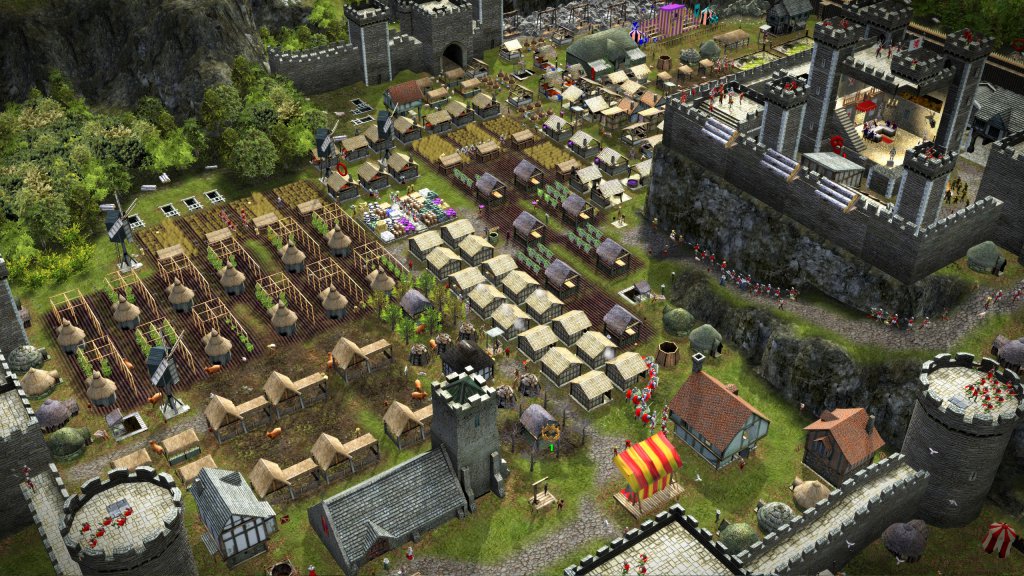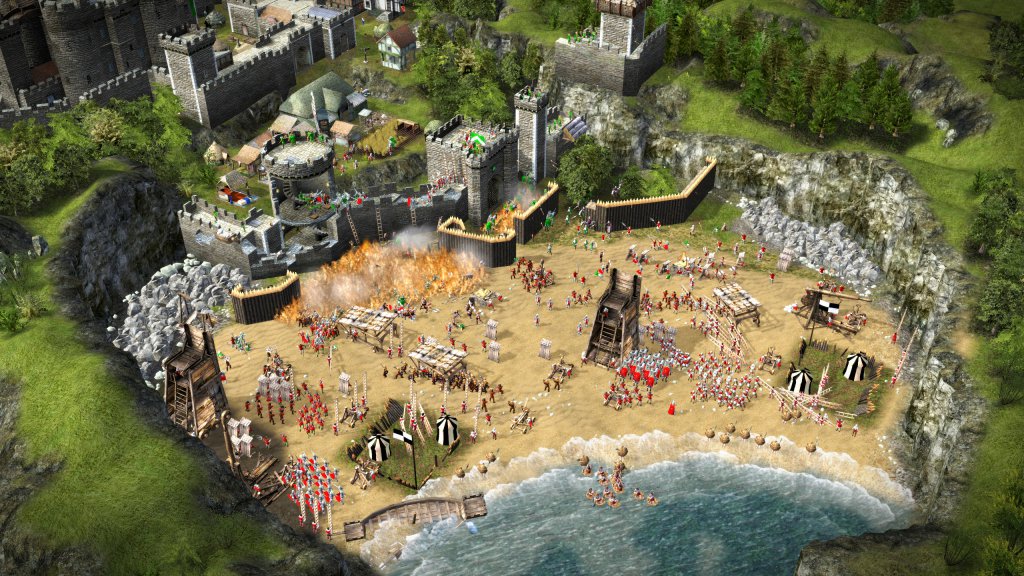It is strange to remember that Firefly Studios’ Stronghold 2 came out over twelve years ago, with concepts, mechanics and gameplay that promised to exceed the already high bar set by its predecessor.
Economy and micromanagement games certainly weren’t a new thing back in the hazy year of 2005; the likes of Caesar, Settlers and even Beasts and Bumpkins had been blazing that trail for nearing a decade prior. Then Stronghold 2 burst through the castle gates of the societal management genre with promises of bigger fortresses, economies spanning multiple settlements and refined combat that actually felt like an enjoyable part of the game, rather than the frustrating distraction of the previous title.
Wind the clock forwards a decade and Firefly Studios has re-released the genre-defining Stronghold 2 on Steam, with all the modern features including facilitated multiplayer, workshop community map support and achievements for killing ten thousand rats.
 It was with this re-release that I found myself faced with the worn, yet familiar, Firefly Studios’ splash screen from my childhood — followed by the opening music reminding me of homework, my brief Dr Pepper obsession and the sound of My Chemical Romance from my teenage sister’s room next door.
It was with this re-release that I found myself faced with the worn, yet familiar, Firefly Studios’ splash screen from my childhood — followed by the opening music reminding me of homework, my brief Dr Pepper obsession and the sound of My Chemical Romance from my teenage sister’s room next door.
I went in with these rose-tinted goggles firmly in place, the knowledge that this game was released before my nephew was born etched into my expectations as I started the campaign.
I was surprised. I remembered a decently fun castle-building game with some elements of ensuring grain from farms was milled into flour and baked into bread. But with a decade more gaming experience under my belt and experience of newer, bigger games, Stronghold 2 was way more complex than I expected. The light baked-goods simulation of yore was actually defined by multiple regions and settlements, their supply chains interwoven into a tapestry of oxen transports, production lines and dedicated poop collectors.
The castle building — arguably the core selling point of the game — was intricate and satisfying to slowly grow and expand. Popping down chunky walls and multi-stage defensive sectors as your fortress absorbed the natural resources around itself and crept progressively further into the surrounding landscape felt organic and fun.
Compared to more modern titles, Stronghold 2 continually surprised me by showing just how ahead of its time it was. That wonderful feeling you get once the key requirements of production lines are in place: the granary, the tool forges and the weaver’s huts, all working in harmony to produce bread, swords and money without your intervention. The overarching system of economic independence is something I don’t recall seeing in full swing until 2010, so for Stronghold 2 to boast it half a decade prior is impressive and competes equally with any current-gen economy game.
 Alongside the economic systems is the management of your peasantry. Through honour generated by tournaments, rationing and lordly parties, you can keep your peasant morale up and have an efficient, clockwork castle. Spanners can and will be thrown into your idyllic system, however, with some peasants deciding work isn’t for them — locking up your key production systems as they strike. You have the ability to administer punishments as you see fit, be they stocks and shame masks to encourage your citizenry to carry on working for fear of social pressure, or going full on despot and burning them at the stake or whacking their heads off. These systems add additional flair to the game overall and provide you with other plates to keep spinning as you fend off bandits and ensure your bread is still being produced.
Alongside the economic systems is the management of your peasantry. Through honour generated by tournaments, rationing and lordly parties, you can keep your peasant morale up and have an efficient, clockwork castle. Spanners can and will be thrown into your idyllic system, however, with some peasants deciding work isn’t for them — locking up your key production systems as they strike. You have the ability to administer punishments as you see fit, be they stocks and shame masks to encourage your citizenry to carry on working for fear of social pressure, or going full on despot and burning them at the stake or whacking their heads off. These systems add additional flair to the game overall and provide you with other plates to keep spinning as you fend off bandits and ensure your bread is still being produced.
Mechanically, the game holds itself high and shows that a good idea ages well regardless of time. However the recent batch of re-releasing older classics has been characterised by the key ‘HD remake’: better sprites, textures and sound effects to bring the glory of the original experience into the modern day. Stronghold 2 was not a HD remake — I knew this, and expected it — but it didn’t make the sudden realisation of just how long twelve years is in terms of gaming progression any easier. Blurry textures and janky models were a sharp reminder of the decade past, but perfectly acceptable with a bit of getting used to.
Stronghold 2 always had strange voice acting before, but both it and the general audio design is painful to a modern gamer’s expectations. The same unit barks on repeat, the frustrating advisor voice berating you each time you misclick when building and the unforgettable peasant reactions to ration changes: ‘More rations? Lovely!’. The game would be far more digestible audibly with a couple days’ worth of re-cast voice acting to bring it up to speed.
The biggest issue for me, however, was Stronghold 2′s UI and UX. I’m not sure if I’ve just become more sensitive to game user experience as a whole since my career path has flung itself in that direction, but Stronghold 2 chucks the laws of UX out of the closest murder hole, crosses its arms and scorns the player whilst they scrabble to decode what the game is trying to communicate at any one time.
 If you don’t play the campaign — which acts as a very long tutorial — the majority of what the game presents to you is unexplained and only discernible through frustrating trial and error, with the ‘error’ part involving the majority of your kingdom on fire or drowning in faeces and rats.
If you don’t play the campaign — which acts as a very long tutorial — the majority of what the game presents to you is unexplained and only discernible through frustrating trial and error, with the ‘error’ part involving the majority of your kingdom on fire or drowning in faeces and rats.
There are a lot of small fixes that could have facilitated the game’s re-emergence into the current decade and made it more palatable to anyone used to modern gaming conventions. You could have tooltips on buildings with hints on what production chain each is involved in: What resources does it need to work? What does it produce and which building uses it? The system of transporting goods is entirely missed out; despite having four stone mines chipping away at the surrounding hills, my available stone wasn’t going up. Turns out I needed to place an ox tether next to my stone mine to transport the mined resources. Even a hint of this connection would have saved a lot of grief. This theme stretches throughout the game, adding barriers and blockades to what is otherwise a great simulation and strategy game.
Overall, Stronghold 2 is a fun game which was mechanically ahead of its time twelve years ago, yet still holds its own against more modern titles. Spurning the trend of HD remakes painfully shows its age with graphics, audio and UX, showing stark contrast to modern expectations after a decade of gaming evolution.
It is currently priced at a reasonable £12 on Steam, which is a standard lunch at any London pub and will keep you entertained for at least the same length of time.
Stronghold 2: Steam Edition is available now on PC via Steam.